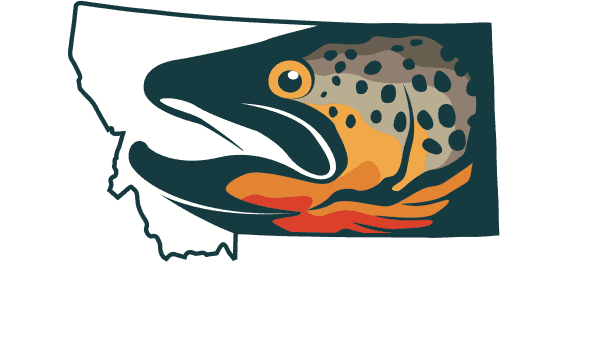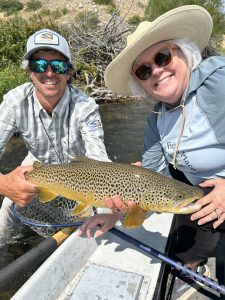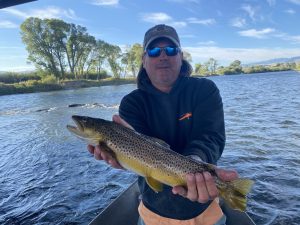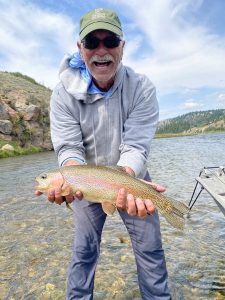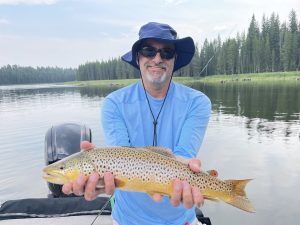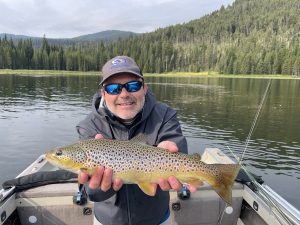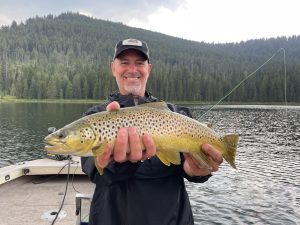AWESOME AUTUMN!
- Fall is here!
- Goodbye Hoot Owl Restrictions
- Yellowstone National Park Waters
- Madison Electrofishing Schedule
- Hot Spots
FALL IS HERE!
You can flock to the Northeast in search of the changing colors of fall, but if you really want to experience the excitement and splendor of Autumn, a river in Montana is the place to do it. When it comes to beautiful scenery, not only do our golden cottonwoods and aspens make for a great photo op, but it’s what in our rivers that put on the real show.
That’s because, from September through November, Montana’s brown trout defy their drab name and transform into the most striking combination of bright red, buttery yellow, and vivid orange. Triggered by cooler nights that drop water temperatures, the largest of these fish, which usually only inhabit the deepest parts of lakes, move to shallow rivers to spawn just as summer fishing restrictions are being lifted. If you’re looking to catch the trout of a lifetime, this is the time of year to do it.
You’d think this would mean the rivers are packed with anglers, but with summer vacations over, kids back in school, hunters in the mountains, and the yearly lull before ski season starts, the crowds dwindle, leaving big swaths of Big Sky country open to first-time and dedicated anglers who know that autumn is nothing short of awesome when it comes to fly fishing in the greater Bozeman area.
GOODBYE HOOT OWL RESTRICTIONS
During the summer months, as Montana’s rivers drop and air temperatures rise, Hoot Owl Restrictions are designated on many rivers. These closures to fishing are usually put in place between 2 p.m. and midnight and can shut down certain sections of a river or even the whole river. They are instituted to protect fish because when water temperatures are higher, there is less oxygen in the water, making it harder for fish to recover from being caught.
But come fall, as the weather cools off and less water is siphoned off by ranchers irrigating their fields, these restrictions are lifted. We’ve already seen countless rivers open back up to fishing and expect more waters to follow suit as the weather continues to get cooler post-Memorial Day.
YELLOWSTONE NATIONAL PARK RIVERS
More good news. The fishing restrictions put in place on the Madison and Gibbon rivers in Yellowstone National Park in July due to warm-water temperatures and unprecedented lows have also been lifted.
This is great for anyone interested in a wade trip targeting the big browns and rainbows that swim upstream from Hegben Lake and the Madison River into park waters. Whether you’re swinging a soft hackle or pounding a streamer, few fishing experiences rival casting for a 20-incher in the world’s first national park, surrounded by its awe-inspiring landscape and legendary wildlife.
While restrictions remain on the thermal-heated Firehole River, with fishing closed daily from 2 p.m. to sunrise the following day, it’s still a great option for those looking to do some dry fly fishing among an otherworldly array of thermal features and grazing bison. Be prepared with White Miller caddis, BWOs, and midges, as well as soft hackles if the fish aren’t rising.
MADISON ELECTROFISHING SCHEDULE
In September, the Montana Department of Fish, Wildlife, and Parks scheduled six zones of the Madison River for electrofishing. This process applies an electrical charge to the water to temporarily stun fish so that biologists can obtain estimates of the numbers, size, and health of fish populations in the river. It is also used to control non-native fish populations and invasive species.
During these dates, it is best to avoid fishing the following sections of the river for your safety and the safety of the fish.
9/10-Between Hebgen and Quake Lakes
9/11-13 – Between Pine Butte and Lyons Bridge
9/17-19 – Between Varney Bridge and 8 Mile
9/20, 23-24 – Between Pine Butte and Lyons Bridge
9/25 – Between Warmsprings and Damselfly
9/26-27, 30 – Between Varney Bridge and 8 Mile
HOT SPOTS
Dam: 806 cfs
Kirby: 976 cfs
Cameron: 1,110 cfs
One of the reasons we love fall so much is the world-class fishing available on the Madison River, as lower temps lead to the action really heating up. We usually start off by targeting the resident fish in the walk-n-wade sections from Raynolds Bridge to Lyons Bridge and from Ennis to Ennis Lake. Using a boat to get from one hole to another lets us cover a lot of water, while wading allows us to use a variety of techniques and flies to find the most fish.
During early fall, terrestrials like grasshoppers and ants will still scare up rising fish, though it’s good to drop a nymph off of either to cover your bases. As the calendar flips from September to October, baetis mayflies, aka blue wing olives, often make an appearance on cloudy days. After lunch, these hatches can be tremendous in terms of the sheer volume of bugs on the river, leading to some of the best fall dry fly fishing around. Be sure to look for fish nosing up in slower water, back eddies, or pockets of flat water, and make sure to match your fly to the size of the bugs you’re seeing.
As it gets cooler and the browns leave the still water to spawn, we target these runners on the sections leading out of Ennis, Hebgen, and Quake lakes in the hopes of catching big fish on the move. Nymph rigs with two flies are a great way to zero in on larger fish hiding in the river’s slower pools.
Big flies can be a great way to target these big fish as well. Enter streamers. Swing ‘em or strip ‘em. Either way, you won’t forget the electricity you feel when a big brown hits your line. You’ll want a mix of colors – some days dark ones work, other days the fish are keying on lighter shades – and make sure they have enough weight to sink into the deeper runs where the big browns hold.
Recommended Patterns
Nymphs
- Pats Stonefly nymph, black with olive legs – size 8-4
- Pats Stonefly nymph, olive with brown legs – size 8-4
- Pheasant Tail Sparkler, 16
- Green Machine, olive & PT – size 16-14
- Lightning Bug, silver– size 14-12
- $3 Dip, brown – size 16-14
- San Juan Worms, red & orange – size 4
- Copper John, red – size 14-12
- Red Fox Squirrel, bead-head – size 12-16
- Egg patterns, orange & pink – size 12
- Prince Albert Soft Hackle – size 14
Dries
- Purple Haze, size 16-14
- Adams, size 16-14
- Royal Wulff, size 16-14
- Parachute fly ant, size 18-16
Streamers
- Barely Legal, olive/white – size 6
- Peanut Envy, olive – size 2
- Delektable Double- Screamer, olive/black, silver – size 6
Water flows and temperatures have to be just right to trigger fish to migrate out of the lakes into the Madison River to spawn. While they wait, they congregate at the inflow of the Madison on the Madison Arm of Hebgen, leading to some of the year’s best lake fly fishing in Montana.
Earlier in the fall, when it’s still warm, Callibaetis can be found hatching from late morning to early afternoon. As things cool off, small trico mayflies take their place. If you can’t get one of these lake gulpers, as they’re called, to come to the surface, nymphing under a dry like an ant or attractor will often do the trick.
As the spawners get restless, inducing a strike with a big ugly streamer in the skinnier water leading to the river can be the way to go.
Recommended Patterns
Nymphs/Emergers
- BH Hares Ear, grey – size 16-12
- BH Red Copper John – size 16-14
- Ice Cream Cone – red or black -size 12-16
- Corona Stoner – size 16-12
Dries
- Callibaetis Spinner AK’s – size 16-14
- Silhouette Dun – size 16-14
- Gulper Special – size 16-14
- Hi-vis flying ant, purple, black and red – size 18-14
- Royal Wolf – size 16-14
- Meanie, Bee – size 14
Streamers
- BH (bead head) Wooly Bugger, black or olive – size 8-4
- Balanced Leach, black, olive, or burnt brown – size 10-6
- Barely Legal, olive/white – size 4
- Peanut Envy, olive – size 8-4
Follow us on Instagram and Facebook for more current and up-to-date information.
